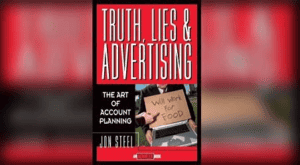It doesn’t take 30-something years of marketing experience to notice a glaring irony in the world of marketing communications.
The vast majority of creative briefs are anything but brief.
As a marketing communications agency, we’re often faced with briefs that are four, five, six pages long – more sometimes.
And ‘single minded’ propositions that can be as many as a dozen bullet points long.
Brief, my arse.
But surely, I hear you cry, a longer creative brief is proof of hard work and due diligence? Surely it offers reassurance that the brief is solid, and fully considered?
Nay, I say. Nay, nay and thrice, nay.
The illusion of completeness
A bulky brief does not mean it’s thorough. Anyone can dump information into a brief without understanding what they’ve done, or why they’ve done it.
A bulky brief is a hedge against the unknown, or more accurately, the undefined. Tossing in everything you’ve got reflects a failure to discriminate between what’s essential and what’s peripheral.
Never mind the quality. Just feel the weight of it.
A long brief isn’t just an oxymoron; it’s a sign of a lack of clarity.
Advertising industry gurus agree with me (or rather, I agree with them).
For example, in his book “Truth, Lies & Advertising: The Art of Account Planning”, Jon Steel talks about the critical nature of the creative brief. He mentions that it needs to be grounded in a human truth and that it’s the planner’s job to distil it down to its simplest form, a single-minded proposition or a question to be solved.
The point of the brief, is to provide the creative team with clarity.
The problem with overstuffed briefs
Ever heard of cognitive overload? It’s a psychological state where an excess of information hampers decision-making and focus. It occurs when we’re overwhelmed with too many choices, and it can cripple the creative process.
The cognitive load theory suggests that our working memory has limitations, and when those limits are breached, the quality of our creative thinking dwindles.
Some might argue (logically) that a detailed brief prevents misunderstandings and helps the creative team consider multiple angles. But that’s a misguided idea.
The longer the brief, the more information it contains – the less clarity you offer.
And the less creative the response.
That’s what happens when a creative brief becomes a dumping ground.
It’s pretty obvious really, but worth remembering.
Why shit happens
So, why does it happen?
Why are so many creative briefs that I see so incredibly long?
The problem as I see it, is two-fold.
The first issue, is that very often, the creative brief sits in the client marketer’s ‘to do’ pile. One of the very many jobs that they have to do that week, alongside budgeting, proof-reading, blog writing, reporting, managing a team, stroking the boss’s ego, meetings, meetings and more meetings.
But creative briefs need to be given more importance than the other stuff. Yes, of course, the other stuff is important too,
Briefs need more thought. Quality thinking time.
It’s rare that clients are afforded that kind of time.
The creative brief is the start of the creative process. If we want the creative output to cut through the noise in the marketplace, then the brief needs to have real clarity of thought. It needs quality time, away from bustle of everyday office stuff.
When that time isn’t available, we tend to throw the kitchen sink at it.
If you’re packing a suitcase at the last minute, you’re way more likely pack stuff you don’t need and forget stuff that’s pretty important.
Problem number two
The other reason for long, overstuffed briefs (and to some degree this is the elephant in the room) is quite simply, a lack of ability.
There are too many client marketers out there who have not been taught how to write a brief properly.
They’ve never been shown how to look at customer data and research in order to put themselves in the customers’ shoes.
They’ve never been given competitor research to do in order to identify their market positionings.
They’ve never been shown how to look at their own product offering through the customer’s eyes.
They’ve never really understood what a single-minded proposition is.
And they’ve certainly never been encouraged to debate whether they’ve even got a decent proposition.
A lack of ability doesn’t mean there’s a lack of intelligence. Far from it. There’s plenty of intelligent client marketers out there, and many who are far, far more intelligent than I’ll ever be.
But unless people are taught HOW to write a brief, then it probably doesn’t matter much how much time they have to do it.
So what does it all come down to?
If you read nothing else in this article, read this
In his book “The Anatomy of Humbug,” Paul Feldwick emphasises the importance of clarity in a creative brief.
He says that if a brief is ambiguous, then the ensuing creative work will be equally muddled.
In short…
Shit in, shit out.
Delivering strong creative work isn’t easy – in fact it’s bloody hard. Getting your brand or product noticed and remembered amongst the noise is a huge battle that most brands will lose.
Good creative delivers competitive advantage.
If you want good creative, you don’t just need good creative people – you need a good brief.
Good briefs only happen if you invest time in them.
Time to train your people, to educate them, to help them learn how to research their market, to learn how to draw insight from information and to distil it into a very clear idea to be communicated.
And time for uncluttered thinking.
Time to write. Time to consider. Time to debate. Time to sharpen.
In the words of Oscar Wilde, “I’m sorry this letter is so long; if I’d had more time, it would have been shorter.”



